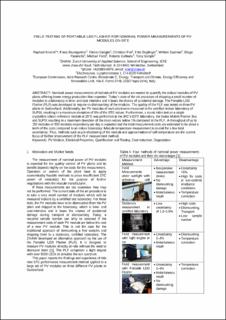Please use this identifier to cite or link to this item:
https://doi.org/10.21256/zhaw-1319| Publication type: | Conference paper |
| Type of review: | Not specified |
| Title: | Field testing of portable led flasher for nominal power measurements of pv-modules on-site |
| Authors: | Knecht, Raphael Baumgartner, Franz Carigiet, Fabian Frei, Christian Beglinger, Fritz Zaaiman, Willem Pavanello, Diego Field, Michael Galleano, Roberto Sample, Tony |
| DOI: | 10.21256/zhaw-1319 |
| Conference details: | 33rd European Photovoltaic Solar Energy Conference and Exhibition (EU PVSEC), Amsterdam, Netherlands, 25-29 September 2017 |
| Issue Date: | 2017 |
| Publisher / Ed. Institution: | ZHAW Zürcher Hochschule für Angewandte Wissenschaften |
| Language: | English |
| Subjects: | PV Module; Electrical Properties; Qualification and Testing; Cost reduction; Degradation |
| Subject (DDC): | 621.04: Energy engineering |
| Abstract: | Nominal power measurements of individual PV modules are needed to quantify the critical modules of PV plants offering lower energy production than expected. Today’s state of the art procedure of shipping a small number of modules to a laboratory is time- and cost intensive and it bears the chance of accidental damage. The Portable LED Flasher (PLF) was developed to require no dismounting of the modules. The quality of the PLF was tested on three PV plants in Switzerland. Additionally, ten PV modules of each plant were measured in the certified indoor laboratory of SUPSI, resulting in a maximum deviation of 3% of the STC values. Furthermore, a round robin test on a single crystalline silicon reference module at 25°C was performed at the JRC’s ESTI laboratory, the Swiss Mobile Flasher Bus and SUPSI resulting in a maximum deviation of the mean values below 1% compared to the PLF. A throughput of up to 150 modules or 500 modules respectively per day is expected and the total measurement costs are estimated to be about a tenth of the costs compared to an indoor laboratory. Module temperature measurement is crucial for a low total uncertainty. Thus, methods such as pre-shadowing of the module and approximation of cell temperature are the current focus of further improvement of the PLF measurement method. |
| URI: | https://digitalcollection.zhaw.ch/handle/11475/1356 |
| Fulltext version: | Published version |
| License (according to publishing contract): | Not specified |
| Departement: | School of Engineering |
| Organisational Unit: | Institute of Energy Systems and Fluid Engineering (IEFE) |
| Appears in collections: | Publikationen School of Engineering |
Files in This Item:
| File | Description | Size | Format | |
|---|---|---|---|---|
| 6CO_15_1_paper.pdf | Paper | 964.7 kB | Adobe PDF |  View/Open |
Show full item record
Knecht, R., Baumgartner, F., Carigiet, F., Frei, C., Beglinger, F., Zaaiman, W., Pavanello, D., Field, M., Galleano, R., & Sample, T. (2017). Field testing of portable led flasher for nominal power measurements of pv-modules on-site. 33rd European Photovoltaic Solar Energy Conference and Exhibition (EU PVSEC), Amsterdam, Netherlands, 25-29 September 2017. https://doi.org/10.21256/zhaw-1319
Knecht, R. et al. (2017) ‘Field testing of portable led flasher for nominal power measurements of pv-modules on-site’, in 33rd European Photovoltaic Solar Energy Conference and Exhibition (EU PVSEC), Amsterdam, Netherlands, 25-29 September 2017. ZHAW Zürcher Hochschule für Angewandte Wissenschaften. Available at: https://doi.org/10.21256/zhaw-1319.
R. Knecht et al., “Field testing of portable led flasher for nominal power measurements of pv-modules on-site,” in 33rd European Photovoltaic Solar Energy Conference and Exhibition (EU PVSEC), Amsterdam, Netherlands, 25-29 September 2017, 2017. doi: 10.21256/zhaw-1319.
KNECHT, Raphael, Franz BAUMGARTNER, Fabian CARIGIET, Christian FREI, Fritz BEGLINGER, Willem ZAAIMAN, Diego PAVANELLO, Michael FIELD, Roberto GALLEANO und Tony SAMPLE, 2017. Field testing of portable led flasher for nominal power measurements of pv-modules on-site. In: 33rd European Photovoltaic Solar Energy Conference and Exhibition (EU PVSEC), Amsterdam, Netherlands, 25-29 September 2017. Conference paper. ZHAW Zürcher Hochschule für Angewandte Wissenschaften. 2017
Knecht, Raphael, Franz Baumgartner, Fabian Carigiet, Christian Frei, Fritz Beglinger, Willem Zaaiman, Diego Pavanello, Michael Field, Roberto Galleano, and Tony Sample. 2017. “Field Testing of Portable Led Flasher for Nominal Power Measurements of Pv-Modules On-Site.” Conference paper. In 33rd European Photovoltaic Solar Energy Conference and Exhibition (EU PVSEC), Amsterdam, Netherlands, 25-29 September 2017. ZHAW Zürcher Hochschule für Angewandte Wissenschaften. https://doi.org/10.21256/zhaw-1319.
Knecht, Raphael, et al. “Field Testing of Portable Led Flasher for Nominal Power Measurements of Pv-Modules On-Site.” 33rd European Photovoltaic Solar Energy Conference and Exhibition (EU PVSEC), Amsterdam, Netherlands, 25-29 September 2017, ZHAW Zürcher Hochschule für Angewandte Wissenschaften, 2017, https://doi.org/10.21256/zhaw-1319.
Items in DSpace are protected by copyright, with all rights reserved, unless otherwise indicated.